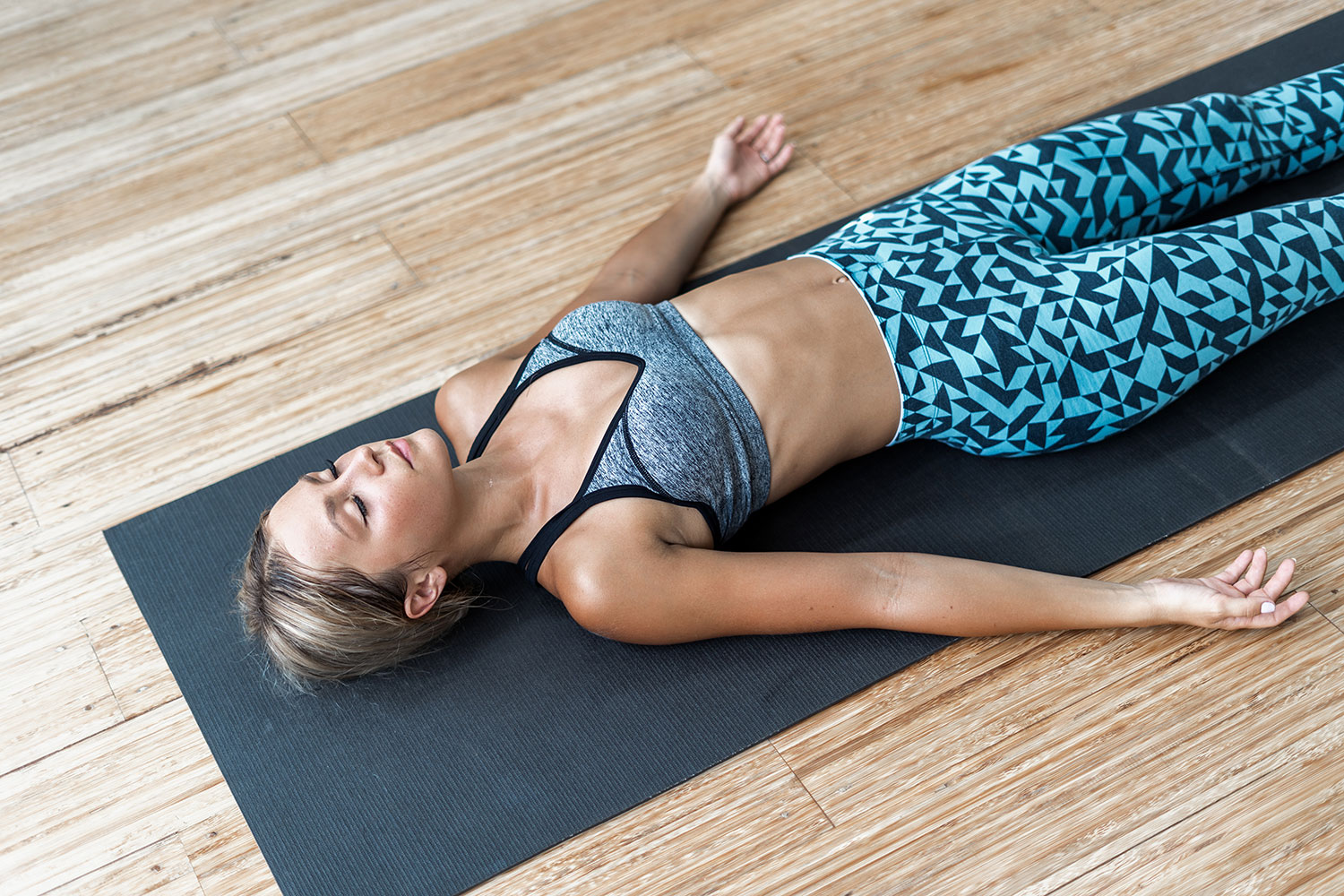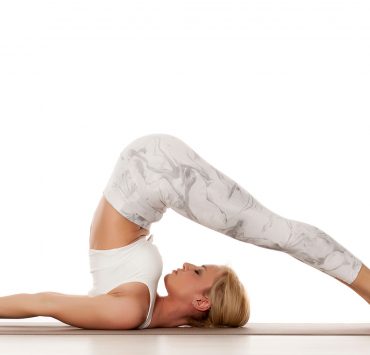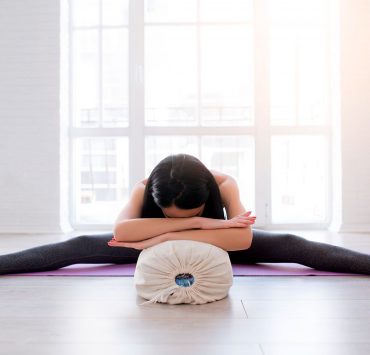
Rose graduated with a degree in Anthropology, which takes her…
Many people who feel stressed or overwhelmed in their daily life turn to yoga for solace. Yoga is praised in popular culture for its calming and relaxing qualities. This promise is supported not only by the thousands of years old history behind yoga, but also many scientific studies.
The success of yoga does not lie in the ability to perform postures but in how it positively changes the way we live our life and our relationships. T.K. Desikachar
Of all the recent studies on yoga’s health benefits, its powers to promote relaxation and reduce anxiety may be the most supported. However, beginner yogis may be intimidated when they enter a class and imagine all the advanced poses they’ve seen on Instagram or in the media. That’s why, particularly for beginners, there are certain yoga poses that will promote relaxation more than others.
How Stress Affects Health

It is said that stress is the root of all disease. To truly advance health and wellbeing, a person must address their stress levels. Although yoga can help with this through its relaxing qualities, it is equally important to understand how stress affects health, and how to modify environment and responses in order to reduce stress.
Each person will respond to stressful scenarios uniquely, and will likely have a changing ‘threshold’ for stress throughout their life. Stress is, biologically, a response of the central nervous system and endocrine system. A person’s body dysregulates its output of cortisol and other stress hormones, as well as increases inflammation. This, in turn, wreaks havoc across the entire body, resulting in symptoms such as headaches, increased heart rate and blood pressure, muscle aches and pains, irritable bowel syndrome, lowered immunity, sleeping problems, sexual dysfunction, and so much more. Combined, all of these symptoms can lead to serious diseases or health events such as diabetes, heart attack, stroke, and more.
Proven Benefits Of Yoga: Reducing Stress
So it is undeniable that stress has a negative health impact, but how does yoga reduce stress? Yoga may be a key aspect of a healthy lifestyle, and an important tool to foster relaxation. Furthermore, this claim is supported by many reliable studies.
One recent study found that a regular yoga practice impacted participants’ overall quality of life. Through yoga, participants improved muscle strength, improved sleep, reduced pain, and more. They also claimed better relaxation. This study held key findings for healthcare practitioners in terms of recommending yoga to patients experiencing stress. These findings are supported in other studies, such as one from 2018 that found regular yoga practice to promote relaxation and reduce depression among women. Although these and other studies show that yoga can increase relaxation, it is not yet completely clear how yoga does this. There are many theories as to how yoga reduces stress so efficiently. Some theories revolve around the neurotransmitter GABA, whilst others claim that yoga modulates a person’s biological stress response. Further research is needed to understand precisely how yoga is so reliable at promoting relaxation.
Targeting Yoga Poses For Specific Benefits

Although research shows that yoga practice will, in general, reduce stress and anxiety, there are specific poses that may enhance this effect. There are hundreds of asanas (yoga poses) and each has a unique effect on the body. Some asanas are energizing, whilst others are more calming. Similarly, there are biological differences behind each pose. Some asanas may improve circulation, others regulate the digestive system, and still others cleanse the lymphatic system and more. It is important to take these differences into account when looking for yoga poses that specifically promote relaxation. One of the best resources on this is the book Light on Yoga by B.K.S. Iyengar.
Light on Yoga is an essential text for anyone who wants to deepen their knowledge on asana and pranayama (breathing techniques). In the book, Iyengar discusses nearly every recognized asana. For each pose, Iyengar provides photos of multiple variations, and detailed instructions on how to enter the pose safely and within the tradition of yoga. Notably, for each pose Iyengar includes an ‘effects’ section. In these few paragraphs, Iyengar details the physical, emotional, and spiritual effects of each pose. Using this as a guide, yogis are able to target their practice to specific ailments by using poses that align with that need. Although yoga in general is labeled ‘healthy’ or ‘relaxing,’ some poses are actually meant to energize or increase vitality. Others foster calmness and relaxation, and should be used for beginner yogis who are seeking relaxation.
Beginner-Friendly Yoga Poses To Promote Relaxation
Based on Light on Yoga, and the thousand year old tradition of yoga, certain poses have become recognized as the essential relaxing poses. Below, the best yoga poses for relaxation are discussed, including emotional and physical benefits.
Salamba Balanasana — Child’s Pose

Child’s pose, or balasana as it is known in Sanskrit, is the most basic of relaxing yoga poses. It is often taught in classes as a pose for students to return to if they are feeling overwhelmed with a sequence, or want to rest. It is usually included in the opening or closing sequences of class.
How to practice Child’s pose: From all fours, sit the hips back and rest the bottom on the heels. Untuck your toes and let the tops of your feet rest on the mat. Walk your arms out in front and reach your torso forward, so your forehead is resting on the mat. From here, close the eyes and breathe into the pose. For variations, arms can reach out in front, and come back along the sides.
Benefits of Child’s pose: Physically, this pose stretched the feet, ankles, lower back, and more. It relaxes the upper back, neck, and shoulders. By breathing into the pose, the central nervous system is regulated, and a safe space of stillness is reached.
Adho Mukha Svanasana — Downward Facing Dog Pose

Downward facing dog is a staple yoga pose, and one of the first that is taught to beginner yogis. It is an essential pose in the sun salutations, and most vinyasa yoga sequences. Downward dog is actually an inversion, and requires both strength (in the arms, shoulders, and thighs), and flexibility (in the hamstrings). Despite requiring all this effort, downward dog is also an extremely relaxing pose.
How to practice Downward Facing Dog: From plank, lift the hips and press back. The hips and sit bones should be reaching toward the back of the room. The yogi should press through all four corners of the palms, keeping the forearms and upper arms engaged. Their heels should reach toward the mat, keeping the thighs engaged whilst relaxing the hamstrings. Shoulders should be relaxing and sinking away from the ears.
Benefits of Downward Facing Dog: Physically, this pose stretches the hamstrings, and calves, whilst strengthening the arms and thighs. The inversion aspect promotes lymphatic drainage and improved circulation, reducing headaches and pains in the neck. It improves posture and opens the chest for improved breathing. Energetically, it gives a sense of relaxation both through its physical aspects and as its symbol in yoga sequences as a place of ‘return.’
Uttanasana — Standing Forward Fold Pose

Standing forward bend (or, uttanasana, in Sanskrit) is another pose from the sun salutation sequence. Although it requires flexibility in the hamstrings, it also holds the potential to be a supremely relaxing yoga pose.
How to practice Standing Forward Bend: From standing, inhale and reach the arms straight overhead. Exhale, and fold forward. Try to hinge from the hips, rather than rounding the spine. This will make the pose more intense for the hamstrings, but will be safer for the back. Let the arms hang down, or alternatively clasp opposite elbows and sway slightly side to side. Let the crown of the head hang toward the floor and make sure there is no tension in the back of the neck.
Benefits of Standing Forward Bend: From a physical standpoint, this pose increases flexibility in the hamstrings. Because it is an inversion, it also is extremely health for the spine, as it reverses the effects of gravity and can create space between the vertebrae. It promotes circulation and relaxes muscles in the neck and shoulders. This can be a very relaxing pose energetically, in part due to its effects on lowering blood pressure.
Viparita Karani — Legs Up The Wall Pose

One of the most restorative and relaxing yoga poses of all is legs up the wall pose, otherwise known as Viparita Karani in Sanskrit. This pose is a favorite in Yin Yoga, and is sometimes practiced during closing sequences. It can be held for as long as the yogi deems necessary.
How to practice Legs up the Wall: In the proper posture, the sit bones are pressed against the base of the wall, with the legs extended straight up the wall. The upper body is relaxed on the floor with arms either outstretched to either side, or resting on the belly.
Benefits of Legs up the Wall: There are many relaxing benefits to this pose, most derived from the reversed effects of gravity on the legs. Lymphatic fluid often stagnates in the legs and feet, and by lifting them up the wall this fluid is drained and detoxified in the lymph nodes. Legs up the wall pose is known to lower blood pressure, improve headaches, digestion, menstrual cramps, and lift the mood. It can also reduce anxiety and depression.
Supta Baddha Konasana — Reclining Bound Angle Pose

Bound angle pose, or Baddha Konasana in Sanskrit, is a centering and rejuvenating pose that is frequently included in closing sequences. Similar to other relaxing poses, its effects are improved the longer that it is held. The yogi should sit in this pose, breathe into it, and notice how it changes with time.
How to practice Bound Angle Pose: From a seated position, bring the soles of the feet together, and let the knees fall open to either side. Using the hands, clasp the outsides of the feet. There are many variations to Bound Angle Pose, including using the hands to open up and massage the soles of the feet, extending the torso forward over the legs, or moving the feet further from the pelvis to create a longer shape.
Benefits of Bound Angle Pose: This pose is, physically, a hip opener. Aside from stretching the hips, hip openers are known to expose the emotions and insecurities, and create a place of vulnerability for the yogi. Other benefits of this pose include stimulation of the reproductive organs and endocrine glands, improving circulation to the lower body, reducing fatigue, and more.
Paschimottanasana — Seated Forward Fold Pose

Seated forward bend is a special pose as it is a perfect counter pose for most backbends. As such, it is usually included in the final poses of the practice. Because the entire body is folded forward over the legs, it creates an enclosed, dark space. This space offers a moment for reflection, breath, and relaxation.
How to practice Seated Forward Bend: From a seated position with the legs together and outstretched, the yogi should inhale and raise the arms overhead, creating space in the spine. On an exhale, fold forward from the hips, extending the upper body over the legs. A clasp can be found wherever is both comfortable and maintains the integrity of the pose (a straight spine). In full posture, this clasp is over the tops of the feet. The yogi should refrain from rounding the spine or closing off the chest. Instead, they should make sure that the pelvis is rotating over the femur bones, and the spine is extended straight, and the chest is reaching toward the feet. The shoulders should relax down the back and away from the ears.
Benefits of Seated Forward Bend: Muscularly, this pose stretches the back of the body. Internally, the forward fold massages the organs such as the reproductive organs, kidneys, intestines, and liver. As such, this aids in digestion, detoxification, and more. Emotionally, this pose can reduce anxiety, lift mild depression, and lower stress.
Sarvangasana — Shoulder Stand Pose

In Light on Yoga, B.K.S. Iyengar refers to Shoulder Stand (or Sarvangasana in Sanskrit) in nearly reverential terms, even calling it the ‘Queen’ of yoga poses. What makes Shoulder Stand such an important yoga pose, though? This pose is highly relaxing due to its effects on the nervous and endocrine system, both of which greatly influence stress levels. Although this pose may look advanced in photos, it is appropriate for beginners. In fact, many children play with shoulder stands not knowing its yogic roots. As such, it may even feel familiar to beginner yogis.
How to practice Shoulder Stand: In most cases, this shoulder stand is entered from plow pose (Halasana), where the legs are extended behind the head, with the hands supporting the lower back. From this position, the yogi should stabilize their hands, and press the backs or their arms and elbows into the mat, keeping the arms parallel to each other. From here, on an inhale, the yogi raises the legs straight up in the air, reaching the feet toward the ceiling.
Using the hands as support, and engaging the core muscles, the body should be in one straight line. To protect the cervical spine, the head should remain straight and never move side to side in this pose.
Benefits of Shoulder Stand: This pose is undoubtedly an inversion, and subsequently carries all the benefits of inversions such as reversing the flow of the circulatory and lymphatic systems. It can therefore lower blood pressure and detoxify lymph fluid. It also regulates both the nervous and endocrine systems, reducing cortisol. As such, it creates a profound sense of calm, relaxation, and peace. It can also improve immunity and improve sleep quality. It is no wonder that Iyengar calls it the ‘Queen’ of yoga poses!
Savasana — Corpse Pose

Corpse Pose (known as Savasana in Sanskrit) is so called as it marks the ‘death’ or end of a yoga practice. It is traditionally practiced as the final pose during a practice, and as a mark of the transition between asana practice and life off the mat. It is no surprise, then, that this pose is one of the most relaxing of all, as it prepares the body and spirit for life off the yoga mat. On paper, Corpse Pose is deceivingly simple. What it lacks in physical challenge it makes up for manifold in the inner spiritual challenge of quieting the ‘mind chatter.’
How to practice Corpse Pose: The yogi should lie flat on their back on the mat. Legs are outstretched, feet a comfortable distance from each other. Shoulder blades are brought together and down the back, opening up the chest. Arms lie outstretched with palms open toward the ceiling. The chin should be slightly tucked in toward the notch of the throat, lengthening the back of the neck. Eyes are gently closed, and the yogi should attempt to empty their mind and enter a state of meditation, absorbing the entirety of their yoga practice.
Benefits of Corpse Pose: Whilst Corpse Pose is not the most physically challenging, it does offer a wealth of internal benefits. Through deep relaxation, it lowers blood pressure, regulates the nervous and endocrine systems, reduces fatigue, and relieves stress and anxiety.
Conclusion
This is just a sample of relaxing yoga poses for beginners. By practicing these poses on a regular basis, in combination with lifestyle and environmental changes, a person can reduce stress and enhance their health and wellbeing.
What's Your Reaction?
Rose graduated with a degree in Anthropology, which takes her understanding of basic human needs to a whole new level. Her intelligence and passion for healthy living is reflected in her written work.














